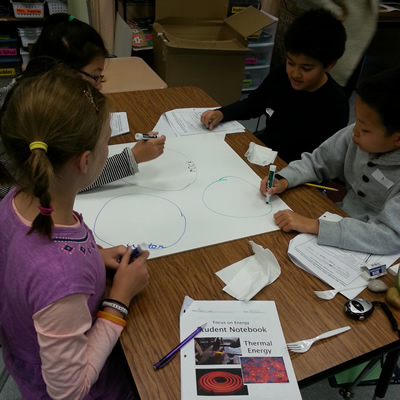Thermal Energy Curriculum Unit Overview

Thermal energy is all around us and is important on all scales, from the human body to the kitchen and the house, from local weather to the global environment. Even when thermal energy isn’t the most conspicuous form of energy in a process, it plays a part in the energy story. All forms of energy can be transformed to thermal energy. For instance, motion energy can be transformed to thermal energy when objects move relative to each other (think of a train wheel on a rail); electrical energy can be transformed to thermal energy (e.g., a toaster), light energy can be transformed to thermal energy (sunlight warms the earth’s surface). Metabolic processes result in thermal energy (keeping you at 98.6 ºF), as do burning, or mixing one substance with another (e.g., chemicals in a hand warmer). When a system appears to “lose” energy, as when a ball rolls to a stop, the energy has not vanished, but has been transferred to the environment, often as heat, light, or sound, and ultimately becomes thermal energy.
We can’t see an object’s thermal energy, but there is a common indicator: temperature. As an object’s thermal energy increases, it’s temperature increases, and as an object’s thermal energy decreases, its temperature decreases. So, we depend on temperature to give us information about changes in an object’s thermal energy, just as we depend on speed to give us information about motion energy and deformation to give us information about elastic energy.
In the Classroom
The Thermal Energy unit is a sequence of four investigations that both introduce new concepts related to thermal energy and reinforce general energy concepts that were introduced in the Motion Energy unit. In this unit, there is increased emphasis on having students develop annotated drawings or representations of their energy stories. These representations allow students to review and reflect on their own thinking and to share their ideas with others and receive feedback, practices that are integral to the work of scientists.
In the first investigation students are introduced to thermal energy and investigate the transfer of thermal energy from hot water to a room temperature rock using both their sense of touch and a thermometer to gather evidence of temperature change. In investigation 2A students use cubes and then create posters to tell the energy story of the rock and the water, and in investigation 2B they share those posters with classmates. In investigation 3 students gather evidence that thermal energy can transfer between an object and air, and they learn about imperceptible changes, since room temperature will not noticeably increase as a cup of hot water cools.
Since everything that students encounter will have some amount of thermal energy (everything warmer than absolute zero, -273ºC, has thermal energy), students’ work in these investigations will focus on changes to an object’s thermal energy. When the “baseline” temperature of an object increases or decreases, the focus is the familiar questions: Where did the energy come from, and where did it go? When students are using energy cubes or energy bars to represent the movement of thermal energy, it’s OK if they decide to ignore the object’s “baseline” thermal energy, often related to room temperature, and focus on the increases or decreases in the object’s thermal energy.
Throughout the four investigations students use the Energy Tracking Lens protocol introduced in the Motion Energy unit as they identify the components of the system they are investigating and create annotated representations that illustrate the flow of energy through the system, note instances of energy transfer or transformation, and account for energy gains and losses.
3 Important Notes about Thermal Energy
1. Thermal energy is related to the motion of an object’s atoms and molecules (scientists call this an object’s internal energy): the more rapidly those particles move, the more thermal energy the object has. If an object’s particles are not moving at all (at minus 273 degrees C, or “absolute zero”) the object has no thermal energy, but anything with a temperature above absolute zero has some amount of particle motion and thermal energy.
2. An object’s thermal energy depends on more than just its temperature: an object’s mass and the material from which it is made are also factors. Because of this, it’s not always clear which object has more thermal energy. A cooler object can certainly have more thermal energy than a warmer object. Here is one example: a bathtub full of 100°F water will have much more thermal energy than a thimble full of 110°F water. Can you imagine a thimble full of 110F water warming up the bathroom in the same way that the bathtub full of 100°F water can? Because the size and material of objects vary, comparing the thermal energy of two or more objects can be very complex and is avoided in these investigations.
3. Thermal energy always flows from a hotter object to a cooler object. In the example above, if you dip the thimble of 110°F water into the bathtub full of 100°F water, thermal energy will flow from the thimble into the tub (100°F), even though the water in the bathtub has more thermal energy than the water in the thimble. When objects have the same temperature, no thermal energy will flow between them. At some point, as the thermal energy flows from that thimble into the tub, the temperatures of the tub water and the thimble water will become the same (at an imperceptible amount above 100°F) and the flow of thermal energy between them will stop.